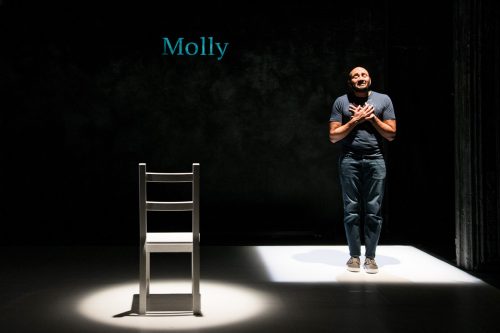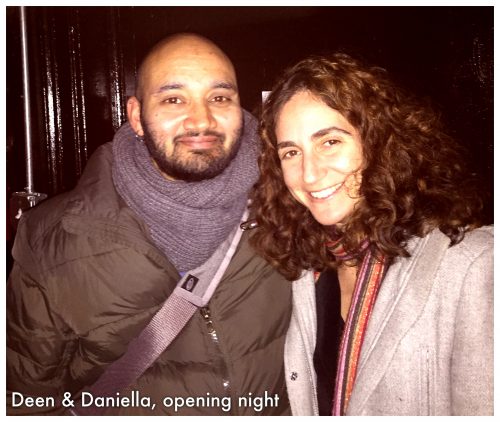
Elaine Romero has been announced as one of the 2018 Artist in residenceawardees from the Headlands Center for the Arts in writing. Learn more about the awards here.

Elaine Romero has been announced as one of the 2018 Artist in residenceawardees from the Headlands Center for the Arts in writing. Learn more about the awards here.
Check out Midday on WNYC‘s podcast: A Play on the Trans Experience, Through Voices of Family with Mashuq Mushtaq Deen, Resident Playwright at New Dramatists, who discusses the New York premiere of Draw the Circle.


In Draw the Circle, a deeply moving one-man work now in its New York premiere at Rattlestick Playwrights Theater, Mashuq Mushtaq Deen tells the story of his transition not through his own eyes but through the perspectives of those around him: loved ones, friends from high school, doctors and nurses, members of his trans support group. First produced in August 2016 at PlayMakers Repertory Company in Chapel Hill, North Carolina, the play is a brilliant intervention into the constrained and prescriptive autobiographical narratives available to queer and trans kids growing up Muslim in post–9-11 America. In writing himself out of his life, Deen enables viewers to access a profound empathy not only for his journey, but also for the struggles of his family and his partner to accept his sexual orientation and gender identity.
Over the course of ninety minutes, Deen takes on a variety of crucial personas — his mother, his father, his partner Molly, his niece Rabia — in addition to the more minor, fleeting ones listed above. Under the skillful direction of Chay Yew (who also did the set design), Deen’s own presence is symbolized throughout by the only object that appears onstage: a white wooden chair that the performer, who also wrote the play, moves around as he toggles from character to character. As Deen inhabits the voices of his friends and family, each individual’s name is projected onto the back wall of the stage. Shifts in persona are also delineated through performance (intonation, accent, posture, positioning), changes in lighting (Mary Louise Geiger), and sometimes sound (Matt M. Nielson).
For many queer and trans Americans who have grown up in Muslim families, storytelling is a business fraught with risk. Those who speak too openly about the complexities of navigating family, faith, and culture can be perceived as reifying Orientalist stereotypes about Muslim families, including that they are homophobic and anti-woman. But there is also a price to be paid for those who dress up their experiences in anticipation of white consumption, sweeping under the rug the challenges they’ve faced in coming out or transitioning. The pain and hardship is real, too, as it is for so many people who come out. Moreover, while reporters and other media-makers are sometimes eager to interview queer/trans Muslims about their lives, they are also quick to reduce these stories to catchphrases or one-liners. After the Orlando shooting nearly two years ago, journalists flooded the inboxes of LGBTQ Muslim activists with interview requests, then turned around stories about how community members were trapped between their two opposing (and, presumably, irreconcilable) selves. “So many articles began to divide our identities as if they were not inhabited in the same bodies,” lamented one queer Muslim at the time.
It’s important to note that Deen does not describe himself as Muslim, or identify as part of the LGBTQ Muslim community. But he’s still penned a play whose very structure troubles the static, flat stereotype of the queer Muslim that we usually encounter in media. We aren’t shielded from Deen’s mother’s shame, or disappointment, or frustration at his transition. We hear it in her own words and voice, along with the reality of what she stands to lose: the respect of family and friends, the future she imagined. Yet we also see her real concern for his welfare and her profound anxieties about his emotional well-being, as when she calls to check up on him after his top surgery. “The worst thing is to imagine your child alone in life,” she notes, fearing the kid she brought into the world will never be married.
Deen struggles with his family’s initial rejection of his choices, but the overwhelming feeling he expresses toward them isn’t anger but love. “I break their hearts,” he tells Molly after he discloses to his parents that he’s getting surgery, tears streaming down his face. Deen’s relationship with his mother and father is wracked with the tensions familiar to so many second-generation immigrant youth: what the extended family or local Indian community will think; a child’s duty to his/her parents; diverging views on the nature of love, happiness, and self-fulfillment. “I will whisper ‘I love you’ quietly, over and over again, that it might be carried on the breeze above your battlements, through your defenses, and with luck, perhaps it will lodge in your heart,” Deen writes in a letter to his mother, read by Molly at the end of the play. “If I say it enough, gently, unarmed and still, perhaps someday your heart will be healed.”
But while Deen’s relationship with his family forms one of the core themes of Draw the Circle, it isn’t the only one. We travel with Deen through the other defining moments of his life, too: His time in a psychiatric hospital; his struggle to determine if and how to transition; his partner’s mourning of the butch dyke she fell in love with, along with her ultimate acceptance of the person he has become. “If she didn’t call, if she got home late, you worry when you’re with a butch,” says Molly of their life together pre-transition. “I don’t worry as much anymore. No one knows. Look at him!” But Molly struggles to adjust to being read as a straight couple. “He has a choice, to tell people he’s trans or not, not like when he was butch — and the choice is his, not mine. How fucked-up is it that I wish people did know?”
In effectively interplaying the two figures onstage — his physical body (in performance) and his true, phantom self (evoked by that lonesome chair) — Deen brings an impressive depth of feeling. Toward the middle of the evening, he takes on the voice of the man who raped him. “American women, mon, they must say ‘no’ or dey feel ashame’, dey do not own dare bodies but dey ant to be taken,” he says, staring back at the chair. Shortly thereafter, he adopts the voice of Molly as she talks about what it’s like when he has a flashback or disassociates. “It’s the worst feeling, to be face-to-face with the person you love, telling them, hold on, stay with me, I’m right here, and then watch her let go and fade before your eyes.”
“The only way I could bring her back from that was to get her to follow the sound of my voice,” Molly adds, as she cradles the chair in her lap and breaks into song. We watch as Deen examines himself from afar, trapped in a moment of fear and vulnerability — a moment of self-exposure so raw and naked it took me aback. At a time when the words queer, trans, and Muslim automatically elicit a series of assumptions, racist stereotypes, and preordained narratives, Deen has managed to pull off a feat that is expansive and nuanced, one that encompasses many (sometimes contravening) truths and realities without sacrificing a sense of emotional wholeness and generosity. For that, he should be applauded.
Read the full story by Aviva Stahl from The Village Voice here.

To learn more about DRAW THE CIRCLE and purchase tickets, please check out the Rattlestick Playwrights Theater.
Mashuq Mushtaq Deen: DRAW THE CIRCLE
Written and Performed By Mashuq Mushtaq Deen
Directed by Chay Yew
Set Design – Chay Yew
Lighting Design – Mary Louise Geiger
Sound Design – Matthew M. Nielson
Previews Begin January 24, 2018
Opening Night: February 2, 2018
Limited Run Through February 18, 2018 Wed-Mon 7:30pm, Feb 3, 10, 11, 17, 18: 2pm

PAWTUCKET — Curt Columbus believes there is a mind-set he calls the “Chekhov Industrial Complex,” which he avoids when translating the great writer’s pieces from Russian to English. When directing his works, he actually pushes quite far in the other direction.
The latter dramatic shift can be seen on stage at the Gamm Theatre where Columbus’s translation of “Uncle Vanya” is now playing. As translator and director of the production, Columbus defies the “Complex” by creating an almost lighthearted approach to the sad tale. Instead of drab and depressing scenes and woe-is-me characters, he has worked with the Gamm company, led by Artistic Director Tony Estrella in the lead role, to create moments of laughter and music, light and even joy.
Vanya finds his world turned upside down when his late sister’s husband, a college professor, shows up on the country estate Vanya has worked his entire life with his new, much younger wife and a host of unreasonable demands. The professor’s announcement that he plans to sell the estate given to him by Vanya’s father as his sister’s dowry leaves Vanya and the others living on the estate shocked.
There are fights and weapons are drawn, there are tears and emotional breakdowns. Chekhov is notoriously long-winded and the conversations and dialogues in “Uncle Vanya” are no exception. But the set, sprawled over three levels on towering scaffolding, and the staging of the scenes are so cleverly executed that the pace of the two-hour show is manageable.
Columbus’ interpretation of the story detours around much of the drudgery. It is still there — Vanya, his niece and the professor’s daughter Sonya, Waffles and Marina work hard and rest little, their hard work funding the professor’s urban lifestyle. The professor is cantankerous and egotistical, leaving his young wife Yelena miserable much of the time. And, Sonya finds herself pining for the local doctor who barely notices her and drowns his own sorrows in copious amounts of vodka.
No, it is not a happy story line, but Columbus infuses lightness, often at unusual moments and, more than once, teetering very close to the edge of meaningfulness. The show, for example, opens with music and simple numbers played on accordions, guitars and xylophones throughout. Perhaps the acoustic version of Soft Cell’s 1980s song “Tainted Love” is a bit much, but the inclusion of music is a nice diversion and transitional tool…
Read the full article by Susan McDonald for the Sun Chronicle here.